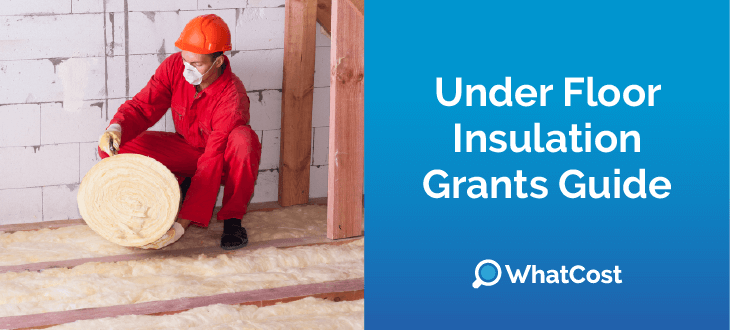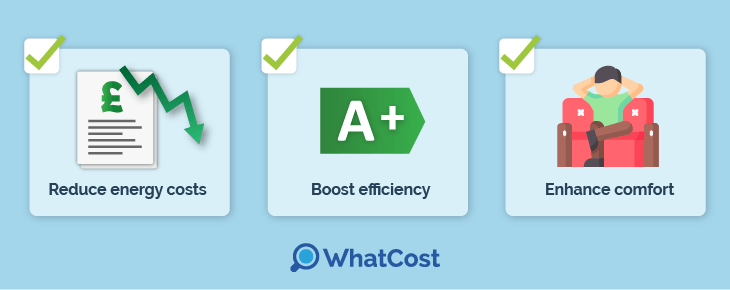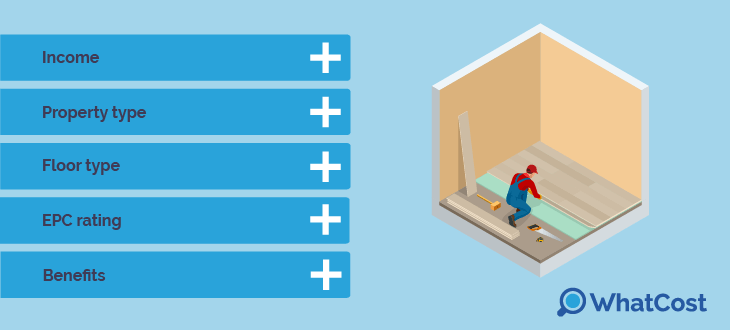Answer these simple questions and we will find you the BEST prices
Which type of solar quotes do you need?
It only takes 30 seconds
100% free with no obligation

Tell us what you need to find a matching specialist

Get free quotes from professionals near you

Compare offers and choose the one that best matches your need
- whatcost.co.uk
- Home Insulation
- Home Insulation Grants
- Under floor Insulation Grants
Under Floor Insulation Grants: How Do They Work? (2025)


- Underfloor insulation grants are government programs that help UK residents insulate beneath their floors, reducing heat loss and saving £110 to £145 annually.
- Grant eligibility depends on your household income, EPC rating, and whether you receive certain benefits.
- Uninsulated floors can account for 10-20% of a home's heat loss, significantly driving up energy bills.
Keeping your home warm and energy-efficient has never been more accessible, thanks to underfloor insulation grants. These government-backed initiatives are designed to help UK residents combat heat loss, lower energy bills, and enjoy a more comfortable living space.
This guide covers the purpose of underfloor insulation grants and their role in reducing floor heat loss. It details eligibility criteria, including income thresholds, EPC ratings, and qualifying benefits, to help you assess your household's qualifications. Lastly, it provides a step-by-step process for applying, from verifying eligibility to scheduling insulation installation.
Are you struggling with rising energy bills but don’t know where to start? Avoid wasting hours navigating eligibility requirements or searching for trusted installers. Simply fill out our 30-second form, and we’ll connect you with up to 3 free quotes from approved installers in your area. Click below now!
- Describe your needs
- Get free quotes
- Choose the best offer
It only takes 30 seconds



What are underfloor insulation grants?

Underfloor insulation grants are government grants for insulation aimed at helping UK residents improve the energy efficiency of their homes by insulating the areas beneath their floors.
- Cut down on energy costs: Underfloor insulation helps prevent heat from escaping through the floor, reducing the energy needed to warm your home. Uninsulated floors can account for 10-20% of a home's heat loss, significantly driving up energy bills. Installing underfloor insulation can save households up to £110 annually in Great Britain and £145 annually in Northern Ireland.
- Boost energy efficiency: Proper insulation effectively retains heat, reducing dependence on heating systems and resulting in significant energy savings. It also contributes to reducing carbon emissions by up to 190 kg of CO2 annually for the average home, making it a cost-effective and environmentally responsible improvement.
- Improved comfort: Insulated floors eliminate drafts and cold spots, providing a consistently warm and cosy environment throughout your home.
Underfloor insulation grant schemes
Underfloor insulation grants allow UK residents to upgrade their homes with effective insulation beneath their floors. These grants are designed to make homes more comfortable and address common issues like cold spots and drafts. Below are the key schemes offering underfloor insulation grants across the UK:
- Great British Insulation Scheme (GBIS): The GBIS, formerly ECO+, helps households in England, Scotland, and Wales access energy-saving measures, including underfloor insulation. This scheme covers both material and installation costs for eligible households, focusing on homes that are harder to heat. Eligibility is based on income, benefits received, and property energy ratings.
- Energy Company Obligation (ECO4): ECO4 is a UK-wide initiative to reduce fuel poverty and improve energy efficiency. It provides grants for measures like underfloor insulation, fully covering the cost of installation and materials for qualifying homes. This scheme focuses on low-income and vulnerable households to help lower energy bills and reduce carbon emissions.
- Home Energy Scotland Grant and Loan: Scotland offers specific support through the Home Energy Scotland Grant and Loan program, which provides financial assistance for insulation upgrades, including underfloor insulation. Homeowners can receive up to £7,500 to cover the cost of materials and installation. This program is particularly valuable for rural and remote households seeking to improve energy efficiency.
- Warmer Homes Scotland Scheme: The Warmer Homes Scotland Scheme offers a range of energy-saving solutions for eligible households, including underfloor insulation. This program fully covers the cost of insulation to reduce energy bills and create a warmer home environment. Eligibility is determined by income and energy efficiency criteria.
- NEST Scheme: The NEST Scheme in Wales is designed to provide free underfloor insulation and other home efficiency measures. Fully funded by the Welsh government, it supports low-income households or those receiving certain benefits. Covering all installation and material costs ensures that homes are warmer and energy bills are significantly reduced.
- Warm Homes Scheme: The Warm Homes Scheme provides insulation grants in Northern Ireland for energy efficiency upgrades such as underfloor insulation. The scheme covers all costs associated with installation and materials, offering an excellent opportunity for Northern Irish residents to lower heating expenses and improve home comfort.
Who is eligible for underfloor insulation grants

Underfloor insulation grant eligibility depends on household income, property type, benefits, and floor type. Here’s what you need to know:
Homeowners and tenants
Both homeowners and private tenants can apply for underfloor insulation grants.
- Homeowners: When considering insulation grants for homeowners, grants typically focus on owner-occupied properties, including landlords who apply on behalf of tenants.
- Tenants: Private tenants must secure their landlord’s permission to proceed with the grant application.
Household income
Grants are targeted toward low-income households. If your annual household income is £31,000 or less, you are more likely to qualify. This threshold includes income from employment, pensions, and other sources.
Floor-type
Not all homes qualify for underfloor insulation. The grants are generally available for properties with suspended wooden floors, as this flooring allows for effective insulation installation. Other floor types may not be covered under these schemes.
EPC rating requirements
Your home’s Energy Performance Certificate (EPC) rating determines eligibility for underfloor insulation grants. An EPC is an official assessment that evaluates a property's energy efficiency, scoring it on a scale from A to G. Homes rated A are the most energy-efficient, while those rated G are the least efficient.
Grants are often prioritised for homes with an EPC rating of D, E, F, or G, as these properties typically lose more heat and require greater improvements. This focus ensures that grants target households most in need of insulation to enhance comfort and reduce energy waste.
Benefits
Receiving certain government benefits can also strengthen your application. Qualifying benefits include:
- Universal Credit: A benefit for individuals and families with low income or who are out of work. If you receive Universal Credit, you will likely meet income-related insulation grant eligibility criteria.
- Income Support: Designed to assist low-income people who are not required to look for work, such as single parents or caregivers.
- Housing Benefit: This benefit helps cover rent for those struggling with housing costs. Receiving it can demonstrate that your household income is below the eligibility threshold.
- Pension Guarantee Credit: A top-up for pensioners on low income, ensuring they have a minimum guaranteed weekly income.
- Child Tax Credit: A benefit for families with children who are on a low income.
- Working Tax Credit: For employed individuals with low income, demonstrating a need for financial support.
These benefits demonstrate financial need and often fast-track eligibility for underfloor insulation grants.
How to apply for free underfloor insulation in the UK
Applying for a free underfloor insulation grant is simple if you follow these steps:
- Check your eligibility: To check your eligibility for a free underfloor insulation grant, ensure that your household income is £31,000 or less annually. Additionally, verify your property’s EPC rating. Lastly, confirm whether you receive qualifying benefits, as these can fast-track your application and improve your chances of approval.
- Contact your energy supplier: Energy suppliers participating in ECO (Energy Company Obligation) schemes can provide advice and support. They’ll guide you through eligibility checks and how to apply for underfloor insulation grants.
- Check with your local council: Some councils offer additional grants or financial aid for insulation. Visit your council’s website or contact them to explore local options.
- Visit the Energy Saving Trust Website: Use the Energy Saving Trust’s resources to find grants in your area and learn about the requirements for each scheme.
- Arrange a home assessment: Book a professional home inspection to confirm that your property is suitable for underfloor insulation. This is especially important if you have a suspended wooden floor, a common requirement.
- Schedule installation: Once approved, certified contractors will install the insulation at little or no cost, depending on the grant’s coverage.
Following the steps to apply for underfloor insulation grants can lead to a warmer, more comfortable home—but we know it can feel overwhelming. There is no need to spend hours researching eligibility or comparing installers. Simply fill in our quick form, and we’ll connect you with up to 3 free quotes from approved installers. Click below to begin now!
- Describe your needs
- Get free quotes
- Choose the best offer
It only takes 30 seconds



FAQ
Yes, you should insulate under your floor to reduce heat loss, lower energy bills, and create a warmer, more comfortable home environment. Underfloor insulation is particularly effective for homes with suspended wooden or uninsulated solid floors.
You can get a grant for underfloor insulation through schemes like the Energy Company Obligation (ECO) or the Great British Insulation Scheme. These programs are designed to help eligible households cover the cost of insulation.
Eligibility for the underfloor insulation grant typically depends on factors like household income (up to £31,000 annually), receiving certain benefits, and your property’s EPC rating (D, E, F, or G). Homes with suspended wooden floors are often prioritised.
Government grants for underfloor insulation include the ECO scheme, the Great British Insulation Scheme, and region-specific programs like Home Energy Scotland and the NEST Scheme in Wales.

Nicole Bea Kerr is a writer for Greenmatch, leveraging her experience in B2B journalism and editing. She is interested in bringing more awareness to sustainability through informative narratives.
- Describe your needs
- Get free quotes
- Choose the best offer
It only takes 30 seconds



